Abstract
People who live near industrial swine operations have reported decreased health and quality of life. To investigate these issues, we surveyed residents of three rural communities, one in the vicinity of an approximately 6,000-head hog operation, one in the vicinity of two intensive cattle operations, and a third rural agricultural area without livestock operations that use liquid waste management systems. Trained interviewers obtained information about health symptoms and reduced quality of life during the previous 6 months. We completed 155 interviews, with a refusal rate of 14%. Community differences in the mean number of episodes were compared with adjustment for age, sex, smoking, and employment status. The average number of episodes of many symptoms was similar in the three communities; however, certain respiratory and gastrointestinal problems and mucous membrane irritation were elevated among residents in the vicinity of the hog operation. Residents in the vicinity of the hog operation reported increased occurrences of headaches, runny nose, sore throat, excessive coughing, diarrhea, and burning eyes as compared to residents of the community with no intensive livestock operations. Quality of life, as indicated by the number of times residents could not open their windows or go outside even in nice weather, was similar in the control and the community in the vicinity of the cattle operation but greatly reduced among residents near the hog operation. Respiratory and mucous membrane effects were consistent with the results of studies of occupational exposures among swine confinement-house workers and previous findings for neighbors of intensive swine operations. Long-term physical and mental health impacts could not be investigated in this study.
Full text
PDF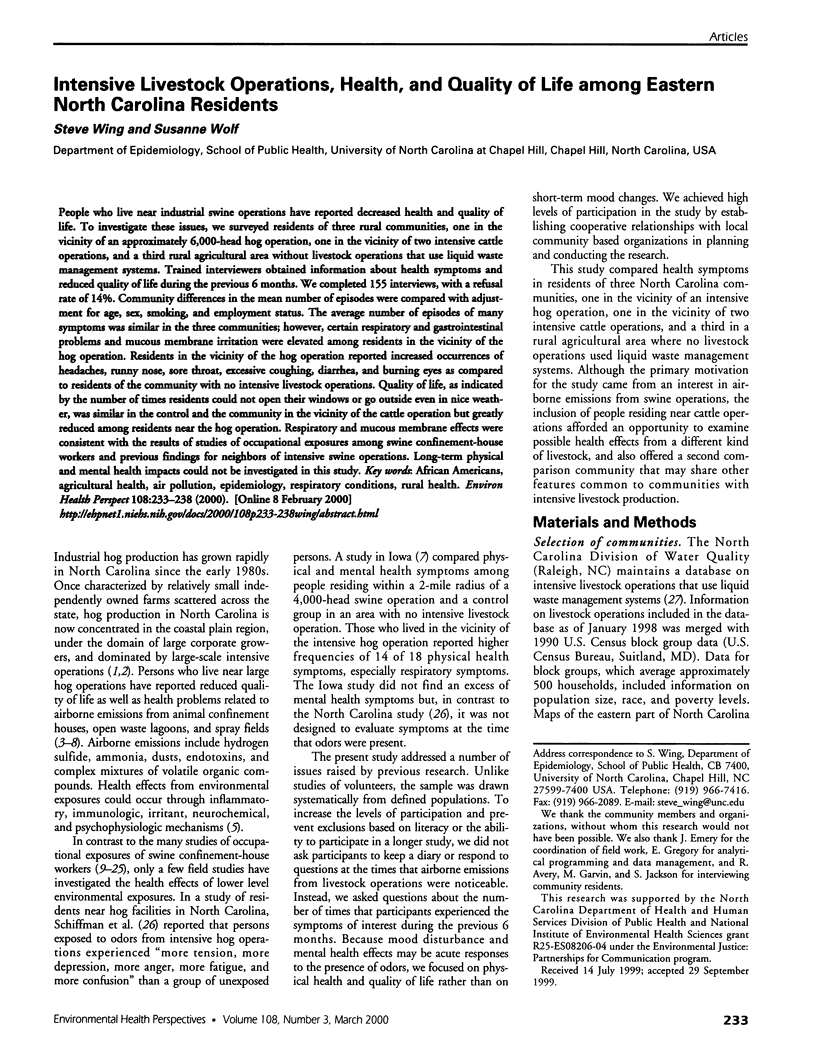
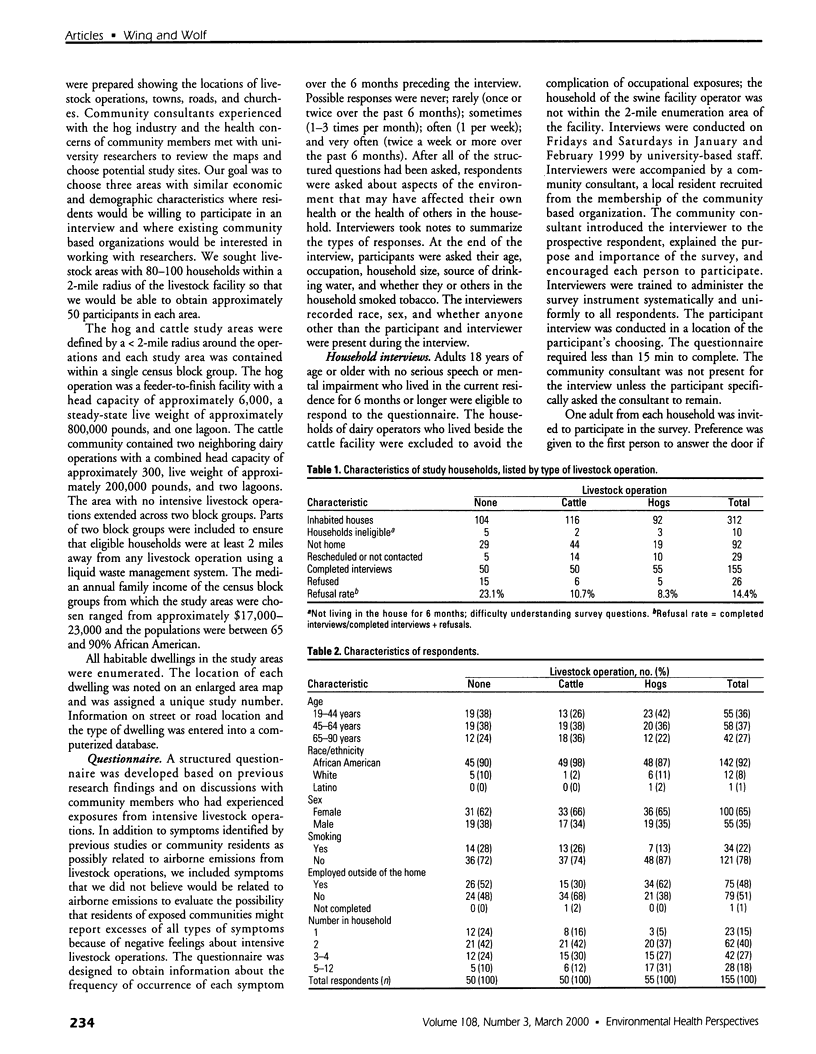
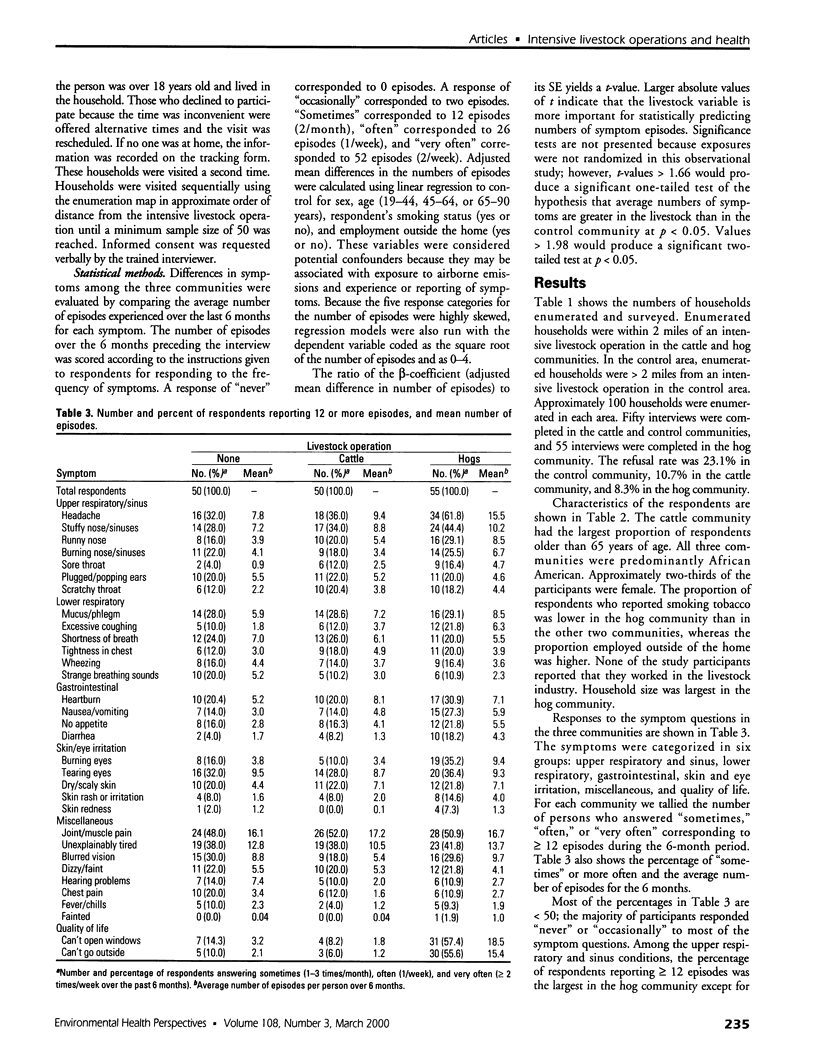
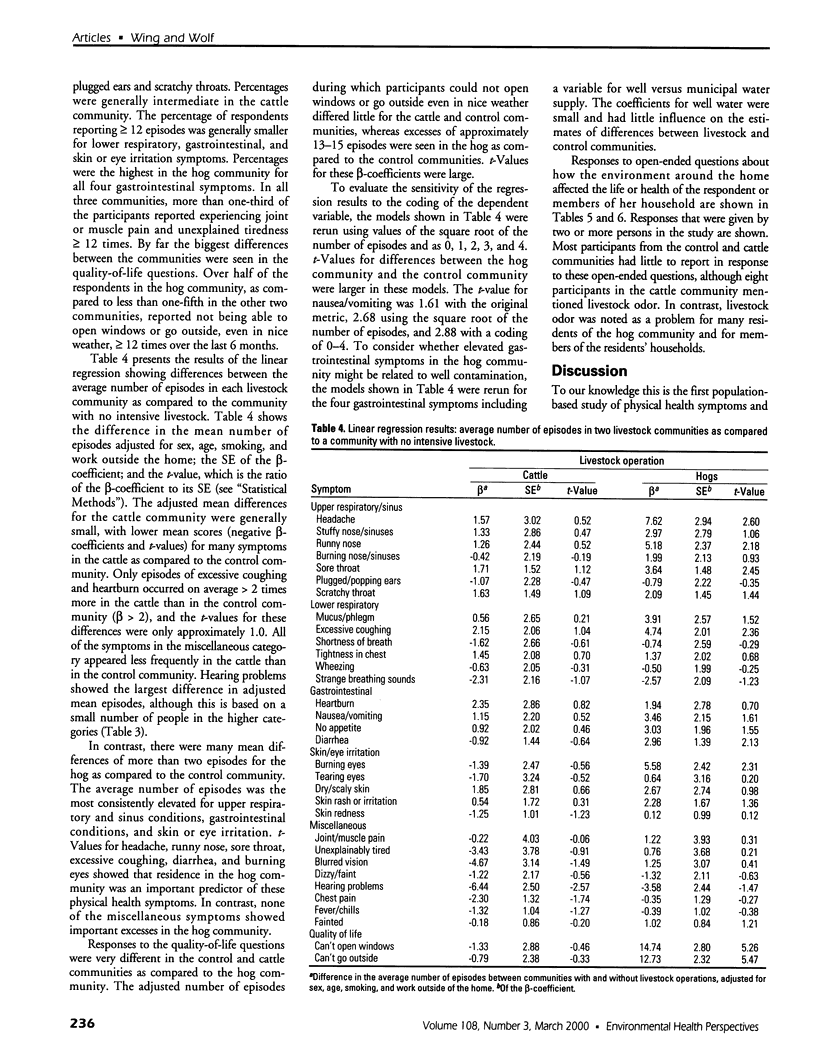
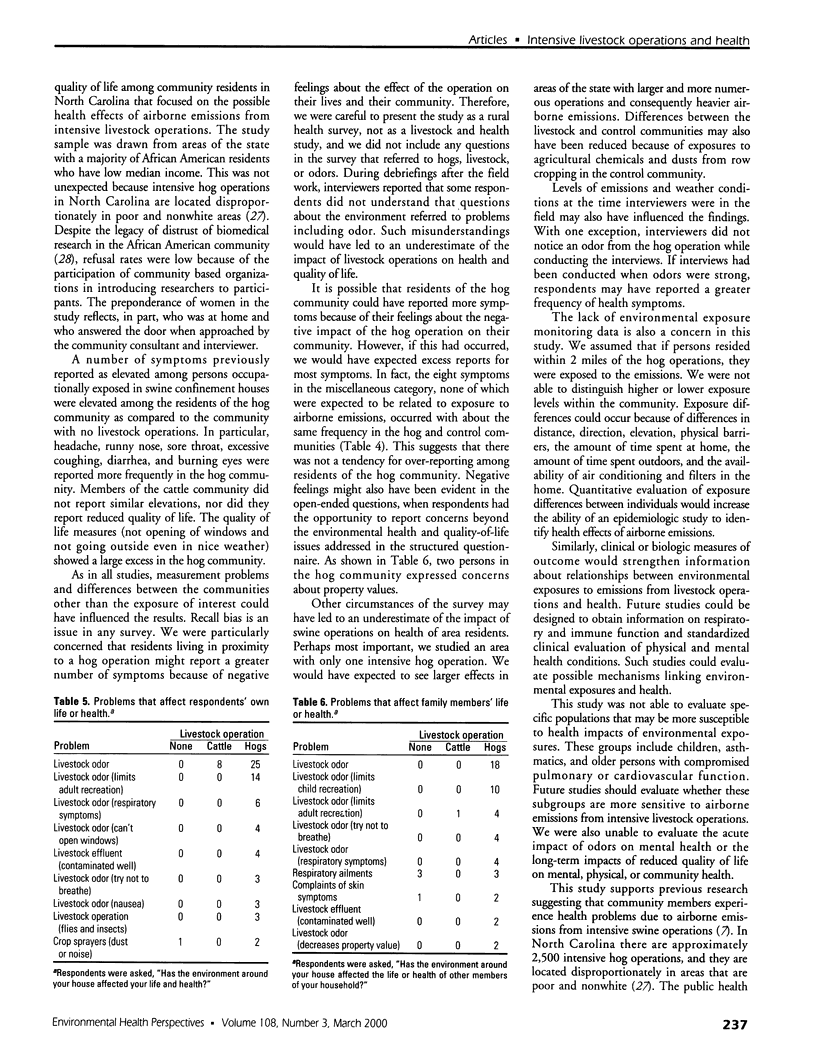
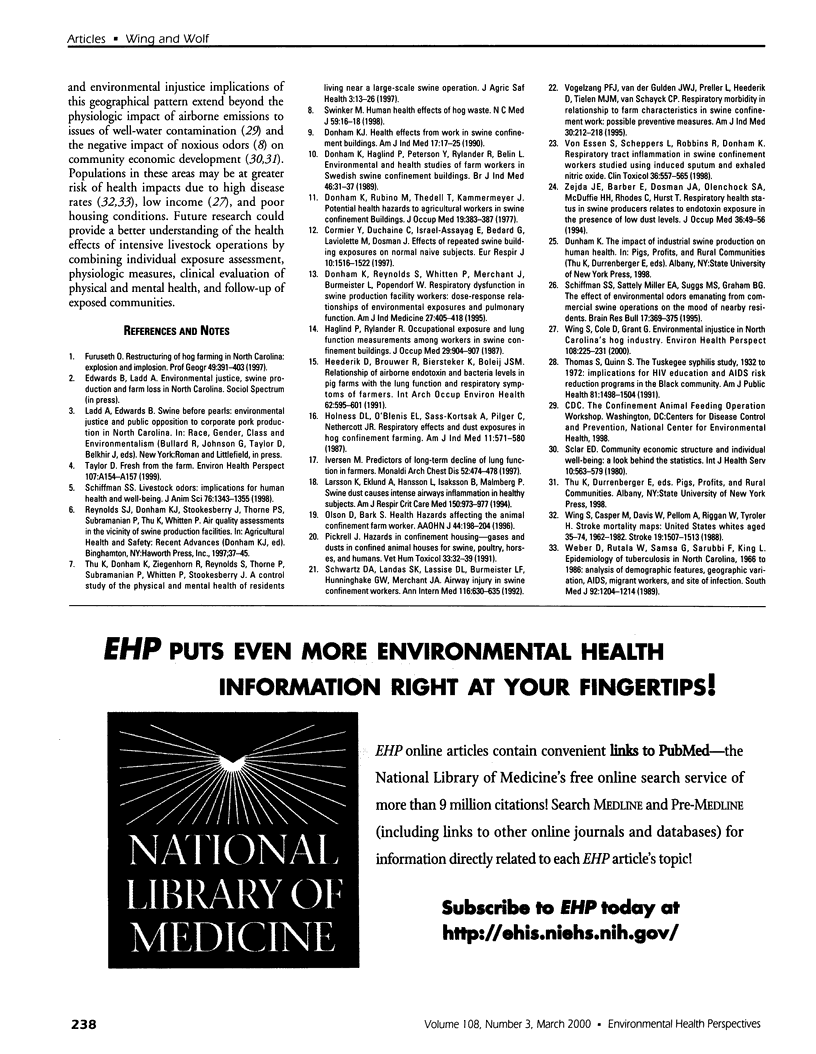
Selected References
These references are in PubMed. This may not be the complete list of references from this article.
- Cormier Y., Duchaine C., Israël-Assayag E., Bédard G., Laviolette M., Dosman J. Effects of repeated swine building exposures on normal naive subjects. Eur Respir J. 1997 Jul;10(7):1516–1522. doi: 10.1183/09031936.97.10071516. [DOI] [PubMed] [Google Scholar]
- Donham K. J. Health effects from work in swine confinement buildings. Am J Ind Med. 1990;17(1):17–25. doi: 10.1002/ajim.4700170105. [DOI] [PubMed] [Google Scholar]
- Donham K. J., Reynolds S. J., Whitten P., Merchant J. A., Burmeister L., Popendorf W. J. Respiratory dysfunction in swine production facility workers: dose-response relationships of environmental exposures and pulmonary function. Am J Ind Med. 1995 Mar;27(3):405–418. doi: 10.1002/ajim.4700270309. [DOI] [PubMed] [Google Scholar]
- Donham K. J., Rubino M., Thedell T. D., Kammermeyer J. Potential health hazards to agricultural workers in swine confinement buildings. J Occup Med. 1977 Jun;19(6):383–387. doi: 10.1097/00043764-197706000-00004. [DOI] [PubMed] [Google Scholar]
- Donham K., Haglind P., Peterson Y., Rylander R., Belin L. Environmental and health studies of farm workers in Swedish swine confinement buildings. Br J Ind Med. 1989 Jan;46(1):31–37. doi: 10.1136/oem.46.1.31. [DOI] [PMC free article] [PubMed] [Google Scholar]
- Haglind P., Rylander R. Occupational exposure and lung function measurements among workers in swine confinement buildings. J Occup Med. 1987 Nov;29(11):904–907. [PubMed] [Google Scholar]
- Heederik D., Brouwer R., Biersteker K., Boleij J. S. Relationship of airborne endotoxin and bacteria levels in pig farms with the lung function and respiratory symptoms of farmers. Int Arch Occup Environ Health. 1991;62(8):595–601. doi: 10.1007/BF00381114. [DOI] [PubMed] [Google Scholar]
- Holness D. L., O'Blenis E. L., Sass-Kortsak A., Pilger C., Nethercott J. R. Respiratory effects and dust exposures in hog confinement farming. Am J Ind Med. 1987;11(5):571–580. doi: 10.1002/ajim.4700110509. [DOI] [PubMed] [Google Scholar]
- Iversen M. Predictors of long-term decline of lung function in farmers. Monaldi Arch Chest Dis. 1997 Oct;52(5):474–478. [PubMed] [Google Scholar]
- Larsson K. A., Eklund A. G., Hansson L. O., Isaksson B. M., Malmberg P. O. Swine dust causes intense airways inflammation in healthy subjects. Am J Respir Crit Care Med. 1994 Oct;150(4):973–977. doi: 10.1164/ajrccm.150.4.7921472. [DOI] [PubMed] [Google Scholar]
- Olson D. K., Bark S. M. Health hazards affecting the animal confinement farm worker. AAOHN J. 1996 Apr;44(4):198–206. [PubMed] [Google Scholar]
- Pickrell J. Hazards in confinement housing--gases and dusts in confined animal houses for swine, poultry, horses and humans. Vet Hum Toxicol. 1991 Feb;33(1):32–39. [PubMed] [Google Scholar]
- Schiffman S. S. Livestock odors: implications for human health and well-being. J Anim Sci. 1998 May;76(5):1343–1355. doi: 10.2527/1998.7651343x. [DOI] [PubMed] [Google Scholar]
- Schiffman S. S., Miller E. A., Suggs M. S., Graham B. G. The effect of environmental odors emanating from commercial swine operations on the mood of nearby residents. Brain Res Bull. 1995;37(4):369–375. doi: 10.1016/0361-9230(95)00015-1. [DOI] [PubMed] [Google Scholar]
- Schwartz D. A., Landas S. K., Lassise D. L., Burmeister L. F., Hunninghake G. W., Merchant J. A. Airway injury in swine confinement workers. Ann Intern Med. 1992 Apr 15;116(8):630–635. doi: 10.7326/0003-4819-116-8-630. [DOI] [PubMed] [Google Scholar]
- Sclar E. D. Community economic structure and individual well-being: a look behind the statistics. Int J Health Serv. 1980;10(4):563–579. doi: 10.2190/1K7N-N25A-BMJ7-PWAX. [DOI] [PubMed] [Google Scholar]
- Swinker M. Human health effects of hog waste. N C Med J. 1998 Jan-Feb;59(1):16–18. [PubMed] [Google Scholar]
- Taylor D. Fresh from the farm. Environ Health Perspect. 1999 Mar;107(3):A154–A157. doi: 10.1289/ehp.99107a154. [DOI] [PMC free article] [PubMed] [Google Scholar]
- Thomas S. B., Quinn S. C. The Tuskegee Syphilis Study, 1932 to 1972: implications for HIV education and AIDS risk education programs in the black community. Am J Public Health. 1991 Nov;81(11):1498–1505. doi: 10.2105/ajph.81.11.1498. [DOI] [PMC free article] [PubMed] [Google Scholar]
- Vogelzang P. F., van der Gulden J. W., Preller L., Heederik D., Tielen M. J., van Schayck C. P. Respiratory morbidity in relationship to farm characteristics in swine confinement work: possible preventive measures. Am J Ind Med. 1996 Aug;30(2):212–218. doi: 10.1002/(SICI)1097-0274(199608)30:2<212::AID-AJIM13>3.0.CO;2-#. [DOI] [PubMed] [Google Scholar]
- Von Essen S. G., Scheppers L. A., Robbins R. A., Donham K. J. Respiratory tract inflammation in swine confinement workers studied using induced sputum and exhaled nitric oxide. J Toxicol Clin Toxicol. 1998;36(6):557–565. doi: 10.3109/15563659809028049. [DOI] [PubMed] [Google Scholar]
- Wing S., Casper M., Davis W. B., Pellom A., Riggan W., Tyroler H. A. Stroke mortality maps. United States whites aged 35-74 years, 1962-1982. Stroke. 1988 Dec;19(12):1507–1513. doi: 10.1161/01.str.19.12.1507. [DOI] [PubMed] [Google Scholar]
- Zejda J. E., Barber E., Dosman J. A., Olenchock S. A., McDuffie H. H., Rhodes C., Hurst T. Respiratory health status in swine producers relates to endotoxin exposure in the presence of low dust levels. J Occup Med. 1994 Jan;36(1):49–56. [PubMed] [Google Scholar]


